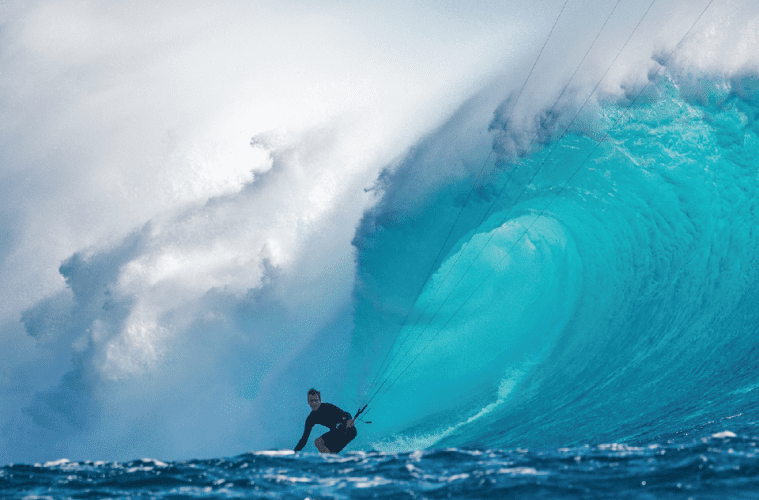Headed by one of the most well-respected kitesurfers in our sport, BWSurf was founded seven years ago by CEO Ben Wilson and designer Dano See. For the 2016 model year, the surf-specific kite company has retired the Noise Pro and now offers two kites in its lineup in addition to three directional boards. The company also offers wave camps in Namotu, Australia and Mexico along with an online coaching program containing over five days (160+ minutes) of tutorials shot on location in Fiji. We caught up with Ben on the heels of his return from Fiji to find out what’s coming down the line.
 Recently, there have been a lot of changes at BWS, particularly the shift from a single kite line to a multiple kite offering. The Noise Pro has long been the root of the BWS lineup. Have you made any changes for 2016?
Recently, there have been a lot of changes at BWS, particularly the shift from a single kite line to a multiple kite offering. The Noise Pro has long been the root of the BWS lineup. Have you made any changes for 2016?
The TDZ is closely based on the Noise Pro, so moving forward, we’ll be running just two kites the TDZ and Æneema. These two designs cater to the full spectrum of surf styles and conditions and are in line with our ideology of wanting to keep kiting as simple as possible. You don’t need 10 different kites; you simply need one, the right one. The TDZ is for pure wave riding and has our signature ”˜drift’ in spades. It’s built for Ian Alldredge’s style and the strong winds at his local break. It’s the kite you want when you want to go big in heavy waves and strong winds. Alternately, the Æneema retains that surf-specific ”˜drift’ quality but has lighter bar pressure and faster turning that excels in all conditions for all skill levels.
The Ian Alldredge TDZ kite was a new addition last year.  How does this kite reflect Ian’s preferences for performance and what unique qualities make this kite stand apart from the Noise Pro?
How does this kite reflect Ian’s preferences for performance and what unique qualities make this kite stand apart from the Noise Pro?
Since the beginning, the Noise kite has been designed to suit the riding styles of Ian and our Pro Team. The TDZ is the next step up from that and is perfect for strong, gusty winds. It turns faster than the Noise Pro, has a pulley-less bridle and a more stable top end. In order to boost big airs, Ian tends to ride a little overpowered but still likes to park the kite and ride the wave. This kite does both really well and will happily fill the gap the Noise Pro left behind.
The Æneema is a new platform for 2016. What were the design goals behind this kite and who is the target rider for this new design?
Our goal with the Æneema was to create something really easy to fly that worked well in tricky onshore to side-onshore conditions. Let’s face it ”” these are the most common conditions. It had to turn quickly but still drift down the line on waves. We wanted it to be beginner friendly yet still give the team riders the level of performance required to ride waves and nail airs. I’m so happy with this design and really excited to hear what others think. So far the response has been incredibly positive. I think people are even getting used to the name!

It looks as if the Undertow bar has remained the same for this year. Our Freeride test team really liked this bar for its balance between simplicity and performance. In your opinion, what are the most important features of this bar?
 Whenever we design something, we think about what it would be like to use in the waves. Things happen quickly and there’s a lot going on so it’s essential to have a simple bar setup that won’t get in the way of riding the wave ”” that’s what it’s all about. The Undertow has everything you need but none of the extras to get caught up in.
Whenever we design something, we think about what it would be like to use in the waves. Things happen quickly and there’s a lot going on so it’s essential to have a simple bar setup that won’t get in the way of riding the wave ”” that’s what it’s all about. The Undertow has everything you need but none of the extras to get caught up in.
When it comes to high performance kitesurfing, building the perfect surfboard pits weight against durability. How have you balanced that with your shapes and what construction technology have you used to achieve that balance?
We only work with the best surfboard shapers and manufacturers. Over the last year we’ve really gone back to basics ”” high quality, high-density foam with the right amount of crosshatched fiberglass. If you use the best raw ingredients in the right way, you don’t need a ton of glass. Creating boards doesn’t have to be tricky and we’re not trying to reinvent the wheel, but the quality of our materials means you end up with a board that is lightweight, less likely to break and most importantly, still has the feel and performance of a real surfboard, which it is! Each board in our line can be used with or without the kite, the true test of any kitesurfing board.
How do you recommend riders choose between Ben’s Signature model, the White Noise and the Drifter?
I’d say the Drifter is the perfect board to start out with in waves with small, mushy conditions. The White Noise is the next step up ”” it performs well in small to mid-sized waves while the BW DHD(Ben’s Signature model) is the high-performance board, perfect for bigger waves and stronger winds.



